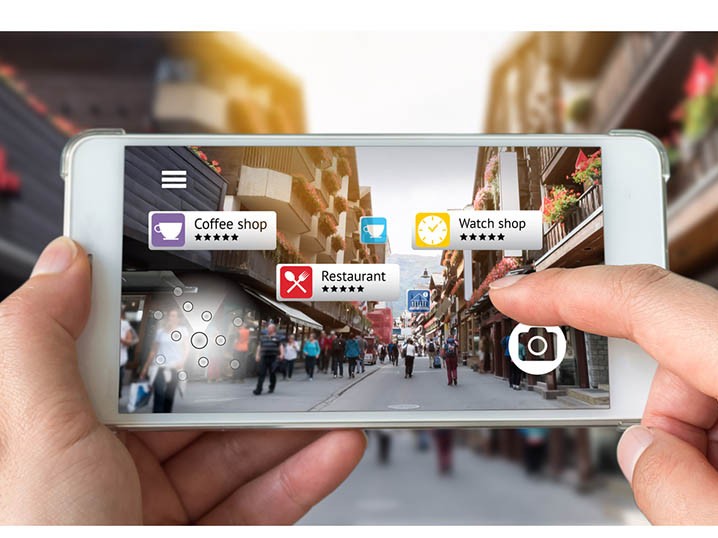News - Digital/Tech
Augmented Reality: a vision of the future
by Iain Akerman
October 12, 2018
.jpg) Advertisement
AdvertisementAnyone who is a fan of The Terminator will be no stranger to augmented reality. Back in 1984, director James Cameron’s sci-fi classic introduced the world to the head-up display of Arnold Schwarzenegger’s T-800 Terminator, whose vision was overlaid with information about the world around him – people, objects, missions. It was a view of the future that was far from far-fetched.
THE POSSIBILITIES
The possibilities surrounding augmented reality (AR) are multifarious, with GPS-enabled, internet-connected mobile devices helping to bring AR to the cusp of commercial viability. Whereas virtual reality (VR) offers escapism into individual experiences, AR blurs the boundaries between the digital and physical worlds, offering the ability to overlay digital data onto real-life environments. It’s a technical feat that excites many within the industry.
“AR has enabled us to change how we view our surroundings, enhancing and adding layers to our experience of the physical world, not just in media and communications, but across industries,” says Brendan Bourke, head of digital across MENAT at UM MENA. “With advances in mobile hardware and OS fuelling AR capabilities, this new world view and experience will soon be commonplace in each of our pockets.”
It is this promise of enhancing our experiences of the physical world that is driving current investment in the realm of AR. Both Apple and Google, the two biggest players in smartphone software, have launched ARKit and ARCore respectively, while Vuzix’s Blade has brought AR glasses back to life after the disappointment of Google Glass. Others, including Samsung and Microsoft, are also investing in the technology, which suggests it is only a matter of time before AR works its way further into the public consciousness, driving increased mainstream usage.
“Unlike VR, which is essentially an immersive experience for one person at a time that isolates the individual from the surrounding environment, AR creates the opportunity for shared experiences that bring together the best of the physical and virtual worlds,” says Dave Coplin, chief envisioning officer at The Envisioners. “For me, that’s the very premise of AR – to blur the boundary between the digital and physical worlds, enabling rich, contextual experiences that add value to whatever the activity being performed.”

“It’s up to brands and marketing professionals to plot the road ahead; the technology is there, ideas and brilliant execution must follow.”--Brendan Bourke, head of digital across MENAT at UM MENA
THE CHALLENGES
Yet we are only scraping the surface of what’s possible with AR. Many within the communications industry continue to view it as a gimmick, despite the success of apps such as Ikea Place, which lets customers see how furniture items would look in their homes.
“As is natural at this stage of a new technology’s evolution there are challenges around hardware and development,” says Bourke. “But as the processing power of portable devices improves so will the user experience. When it comes to development, access to skilled resources will improve steadily and the price of entry will fall.”
Within marketing and communications the challenges can be broken down into two areas, believes Bourke – those based on perception and those based on reality. A recent study of marketing executives in the US by the Boston Consulting Group (BCG) highlighted these challenges.
“One of the challenges mentioned is ‘scale’,” says Bourke. “Although there is not mass adoption yet, there are already a substantial number of AR users, so scale is technically not a major issue. There are also some challenges around general AR knowledge and understanding among marketers. Measurement and lack of expertise were highlighted in the BCG study as issues, which points to the more tangible struggle of marketers trying to get to grips with a new technology. These types of growing pains could be expected when it comes to any nascent technology trend.”
THE POSSIBILITIES
Despite these growing pains data from software company YouAppi revealed that 21 per cent of digital marketers worldwide planned to use AR to support the customer journey in 2018 versus 13 per cent in 2017, “so adoption and resource allocation are most certainly trending upwards,” adds Bourke.
“A lot of the challenges AR faces are around expectations,” adds Coplin. “People tend to think of AR as in Pokemon Go, not as in ‘search’, and so content providers are sometimes reluctant to develop AR solutions because they fear the complexity and cost of doing something rich and meaningful. But it doesn’t have to be three dimensional virtual graphics popping up, although they’re nice if you can do it.”
He adds: “Every time you pick up your phone or similar device to find the address of a restaurant or the price of a product elsewhere you are augmenting your real life experience with information that helps you make better decisions and achieve better experiences. As the interface for search moves from a dialogue box to voice and, ultimately, to the camera in your device, the power of this augmentation will just get stronger and more ingrained in our everyday lives.”
The possibilities of search within AR are enormous. Imagine a world in which you can search for a shop, person, restaurant or venue by voice, with the result of that search then overlaid on your field of vision. It is a techie’s dream, but also an advertiser’s.
Within the automotive industry AR is being championed as the future of car navigation systems, with windscreens acting as a head-up display, providing information such as speed and navigation prompts. All of which will be overlaid on the driver’s view of the road ahead.
“From a communications perspective, where there are users and eyeballs there is opportunity,” says Bourke. “But brands need to find their place, they need to add value and utility and resist the temptation to be faddish and opportunistic. For advertisers it’s not only about creating bespoke user experiences, there are many ways to get involved in AR from a media perspective. For example, Snap and Facebook are major players with Snap Lens Studio, Facebook AR studio and Facebook’s AR News Feed ad formats.”
Yet, as with all developing technologies, there are genuine concerns surrounding the wider application of AR, particularly as it relates to a Terminator-esque vision of the world around us.
“We’ve got some way to go yet before the form factors fundamentally move beyond a smartphone handset,” says Coplin. “There are still many social, ethical and technological hurdles to cross before we can feel as comfortable with a pair of AR glasses as we do with a smartphone in our hands. We would do well not to under-estimate the challenge of the ethical and social issues surrounding this technology, and as a result I think we need to put more effort into discussions around privacy as well as the unintended consequences of the prevalence of the technology that makes all this possible.”

“Unlike VR, which is essentially an immersive experience for one person at a time that isolates the individual from the surrounding environment, AR creates the opportunity for shared experiences that bring together the best of the physical and virtual worlds.”--Dave Coplin, chief envisioning officer at The Envisioners
Whichever way you look at it, the possibilities provided by AR for the communications industry are huge. The Boston Consulting Group estimates that nearly 80 million people in the US engage with AR on a monthly basis. That number is expected to grow to 120 million by 2021. “So challenges notwithstanding, growth is inevitable,” believes Bourke.
“It’s up to brands and marketing professionals to plot the road ahead; the technology is there, ideas and brilliant execution must follow,” says Bourke. “One thing we can certainly predict is that brands will seek to enhance consumer journeys using immersive AR experiences and personalisation. The entertainment industry will continue to embrace AR with the development of both content and gaming. As a result, in-game AR advertising will likely explode. Another inevitable development is the further expansion of AR into OOH [out-of-home]. This will be a very natural evolution in the same way that OOH embraced digital.
“Of course, AR will not just impact marketing and advertising, and many of the most important cases will continue to emerge and evolve across all sectors such as education, medical, retail and manufacturing. As marketers we’re guests at the AR party, so let’s make sure we have something interesting to say. Ultimately, AR is most certainly here to stay. That’s a reality we all need to embrace.”




.jpg)










